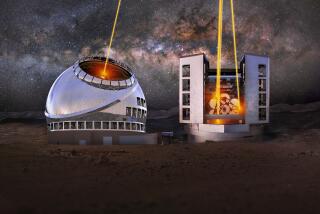Tuning In to Need to Study Distant Skies : Yellow Street Lights Help Search for Answers, Astronomer Says
When you look at the night sky from downtown San Diego, all you can see are the brightest stars. The Milky Way and faint stars are completely overwhelmed by the city lights.
In the same way, when astronomers at Palomar Observatory use the 200-inch Hale Telescope to study distant galaxies and quasars, they too are hampered by interference from city lights. This is called light pollution. The only difference between these two examples is that the astronomers need to study celestial objects several million times fainter than can be seen by eye.
Over the last few years, Caltech’s Palomar Observatory has been the object of attention as we worked with local communities to control light pollution that would severely hamper scientific research being conducted there. One visible result of our effort is the growing use of the deep yellow, low-pressure sodium street lights in the area. I know some residents find these lights objectionable and ask whether they are really worthwhile. I think they are. Let me explain why.
In the past, most of the public discussion has been on the technical aspects of light pollution with relatively little attention to the importance of Palomar Observatory as a major scientific resource. Why is it important to protect Palomar Observatory? The question is deceptively simple; the answer is much more complex and, to a certain extent, depends on one’s personal sense of history and values. It is part of the larger matter of the role that basic scientific research plays in our world.
By its very nature, much of basic research seems disconnected from the day-to-day world we live in. But that isolation is not real. In some instances, like medical research, the connection between basic science and society is fairly obvious. In others, like astronomy, it is more subtle and more difficult to see. Nevertheless, it is there and it is important.
I believe that much of the motivation for scientific study derives from our innate curiosity. We simply want to know how things work. A look at the multitude of celestial objects we see in the sky, for example, stimulates volumes of questions. How is it possible for a star like the sun to radiate its life-giving energy for more than 5 billion years? How was the solar system formed? Are there other planetary systems? How did the galaxies form, and why do they look the way they do? What is the structure of the universe? How was it created? What is its fate? The desire to answer these and other similar questions is, for many, sufficient reason to support astronomy. But what about non-astronomers? What does our research have to do with them?
We live in a technological world that is the result of 40 or more centuries of observing natural processes and using them to improve our way of life. Great progress toward understanding has come through science--the rational examination of causes and relationships in nature--enabling us to construct a mosaic of natural functions. Because of the unity of nature, the mosaic is the important thing, a single entity, even though we sometimes divide it artificially into individual pieces such as astronomy, physics, biology, geology, etc. Each piece contributes to the whole and, in return, gains from the whole.
There are compelling reasons to believe that the technological leadership of the United States is the result of years of basic research, work not necessarily aimed at specific material goals but done instead with the realization that the increased knowledge would eventually enrich our society. There are equally compelling reasons for the growing concern that a declining commitment to basic research will undermine our future technological base and, as a consequence, our future economic well-being. Science must remain secure if the very foundations of our technological system are to remain sound.
The history of science as a whole is rich with examples of how it has gained from advances in astronomy. The rise of mathematics, Newton’s laws of motion and of gravitation, quantum mechanics, Einstein’s theories of relativity all were stimulated, at least in part, by questions arising in astronomy. All have had profound effects on our civilization. More important, the process continues as, for example, astronomers and physicists explore the origins of the universe by studying the very large--observational cosmology, a specialty at Palomar Observatory--and the very small--high-energy subatomic physics. Who today can predict the results of what will be learned from this research? I can’t. But I am certain that, in time, the knowledge we gain will work its way into the fabric of our society.
The 200-inch Hale Telescope atop Palomar Mountain is one of the few instruments in the world that astronomers can use as they continue to probe the limits of our understanding. This telescope’s ability to collect the exceedingly faint light from the most distant objects in the universe is undiminished by time. Indeed, because of the new electronic sensors now employed, the 200-inch telescope is more powerful than ever before. Its best work is yet to come. This is why we are working so hard to protect it. Writing in 1928 about the prospect of new large telescopes, George Ellery Hale said of astronomy: “While much progress has been made, the greatest possibilities still lie in the future.” It was true then. It is equally true today.






